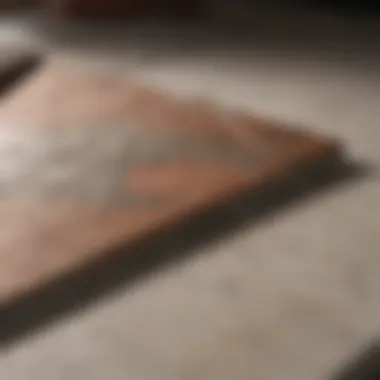Mastering Tile Backsplash Installation: A Complete Guide


Intro
Installing a tile backsplash is a common home improvement project that not only enhances the functionality of a kitchen but also adds a visual element that can transform its aesthetic. This guide is designed for homeowners and design enthusiasts alike, offering step-by-step instructions on how to successfully install a tile backsplash. From selecting materials to learning installation techniques, this guide will cover all essential aspects, ensuring you approach the project with confidence and detail.
A tile backsplash serves various purposes, including protecting walls from splashes and spills, as well as providing an opportunity for personal expression through design choices. The right backsplash can become a focal point in the kitchen, elevating the overall atmosphere of the space. By understanding the key elements of planning, tools, and techniques, readers can execute this project without the need for professional assistance.
This guide will explore design inspirations, material considerations, installation tips, and maintenance advice, catering to both the practical and aesthetic needs of the project. As we go deeper into each topic, the aim is to empower you to make informed decisions that reflect your style while ensuring a durable and visually pleasing result.
Understanding the Tile Backsplash
A tile backsplash is more than just a functional addition to your kitchen or bathroom. It serves a crucial role in protecting walls from moisture and splatters while adding an aesthetic element to the space. Understanding the significance of a tile backsplash helps homeowners make informed choices about design, material, and installation. The right backsplash can enhance the overall look of a room, contributing to its style and ambiance.
Definition and Purpose
A tile backsplash is a protective surface installed on the wall directly behind a sink or counter. Its main purpose is to prevent water and food particles from damaging the wall, which can lead to mold and mildew over time. In addition, a tile backsplash can be a beautiful focal point. Homeowners can choose from various materials, colors, and designs to create a look that complements other elements in the space.
Benefits of a tile backsplash include:
- Protection: It safeguards the wall, prolonging its life and maintaining cleanliness.
- Aesthetic Appeal: A well-designed backsplash can enhance the style of the kitchen or bathroom.
- Easy Maintenance: Tiles are generally easy to clean and maintain compared to paint or wallpaper, which can deteriorate quickly in moist environments.
Historical Context
The use of tile backsplashes has a long history, dating back to ancient civilizations where ceramics were employed for both practicality and decoration. The Chinese, for example, used glazed tiles in their kitchens to protect walls and create intricate designs, showcasing artistry and craftsmanship. In Europe, particularly during the Renaissance, tiles became a means of displaying wealth and culture in the homes of the elite.
In modern times, the tile backsplash has evolved to suit various design trends, moving from simple protection to a central design element in kitchens and bathrooms. Today, it reflects personal style and can make a significant statement in interior design. As homeowners increasingly seek customized and unique looks, understanding this historical context can enhance appreciation for modern tile backsplash designs.
Design Considerations
Design considerations in a tile backsplash installation are crucial. The right choices in material, color, and size can enhance the aesthetic value and functionality of a kitchen. This section will delve into selecting tile materials, exploring color schemes and patterns, as well as examining the variety of sizes and shapes available. Each aspect contributes significantly to the overall look and feel of the kitchen space.
Selecting Tile Material
Choosing the right tile material is fundamental to the success of your backsplash. The material not only influences the visual appeal but also impacts durability and maintenance.
Ceramic Tiles
Ceramic tiles are a popular choice for many homeowners. Their affordability and variety of colors and patterns make them attractive. They are easy to clean and resistant to moisture, which helps in maintaining a hygienic kitchen environment. One unique feature of ceramic tiles is their ability to mimic the look of other materials, such as wood or stone.
However, ceramic tiles can be prone to chipping if subjected to heavy impacts. Despite this, their wide availability and ease of installation keep ceramic tiles a favored option for backsplashes.
Glass Tiles
Glass tiles offer a modern and sleek appearance, bringing a touch of elegance to any kitchen. Their reflective surface can enhance natural light, making the space feel larger and brighter. This feature is particularly appealing for smaller kitchens.
One of the main advantages of glass tiles is their resistance to staining and fading. They also are available in a range of colors and can be used to create stunning mosaic patterns. However, glass tiles can be more expensive compared to other materials, and installation may require professional assistance due to their fragility.
Natural Stone Tiles
Natural stone tiles, like granite, marble, or slate, provide a unique and luxurious touch. Each tile showcases distinct patterns and colors, which adds character to the backsplash.
These tiles are highly durable, making them a strong choice for a kitchen. However, they typically require more maintenance because they may need sealing to prevent staining and water damage. Natural stone's weight and need for precise cutting could also complicate the installation process.


Color Schemes and Patterns
The color schemes and patterns you choose are essential in creating a cohesive look. Neutral colors like whites, grays, and beiges promote a sense of openness, while bold colors can serve as focal points. When mixing patterns, it is advised to limit the variety to prevent overwhelming the space. Consider the overall ambiance you want to achieve.
Some popular patterns include subway tiles arranged in a herringbone design or staggered layouts, which add interest without cluttering. When choosing colors and patterns, ensure they complement your kitchen cabinets, countertops, and overall decor.
Size and Shape Options
Tiles come in various sizes and shapes, allowing for creative expression. Common tile sizes range from small squares to larger rectangles, which can significantly impact the overall appearance of the backsplash. For instance, larger tiles can create a seamless look and require less grout, while smaller tiles are better for intricate designs.
You can explore shapes such as hexagons, octagons, or elongated diamonds for a modern touch. Additionally, use a variety of shapes to add depth and interest to your backsplash without making it appear busy. When selecting size and shape, maintenance considerations also should be taken into account as more grout lines can mean more cleaning.
In summary, careful thought in the design considerations of tile material, color schemes, and size shapes will ensure a more rewarding and visually pleasing tile backsplash installation.
Tools and Materials Required
In the journey of installing a tile backsplash, having the right tools and materials is critical. The importance of this topic cannot be understated. Proper tools not only ensure precision in every step but also enhance the overall efficiency of installation. When you gather essential tools, it transforms what could be a challenging task into a more manageable and enjoyable one. The right materials, on the other hand, contribute to the durability and aesthetic appeal of the backsplash.
Essential Tools
Tile Cutter
A tile cutter is essential for achieving precise cuts for your tiles during installation. This tool allows you to create straight lines, which is vital for a neat appearance. The key characteristic of a tile cutter is its capability to score and snap tiles cleanly. This feature makes it a popular choice among DIY enthusiasts.
The unique feature of a manual tile cutter is its simplicity and effectiveness for straightforward tile jobs. However, it might struggle with thicker tiles or intricate cuts, which may require a wetsaw. A tile cutter saves time and effort, which is a significant advantage for both seasoned professionals and new installers alike.
Trowel
The trowel serves multiple purposes in tile installation. Its primary function is to spread adhesive uniformly on the surface where the tiles will be laid. The key characteristic of a trowel is the notched design of its blade, which creates ridges necessary for even adhesive distribution. This makes it an indispensable tool in this article.
A unique feature of the trowel is its flexibility; different sizes and notch patterns can be used depending on the tile type and adhesive. This adaptability allows for greater control during application. One consideration is that using the incorrect trowel size could result in poor adhesion or uneven tile placement. Doing so might lead to complications down the line, making the right choice quite important.
Grout Float
The grout float is another key tool, specifically for applying grout between tiles. It allows for even filling of joints without damaging the tiles. Its key characteristic is the smooth rubber surface that effortlessly spreads grout while maintaining the necessary pressure. This makes it a essential piece in achieving a professional look.
One unique feature of the grout float is its angled edge, allowing you to reach into tight spaces effectively. On the downside, proper technique is needed to avoid pushing too hard and displacing the tiles. Given its pivotal role in the finishing stage, mastering the use of this tool will directly influence the final appearance and durability of your backsplash.
Adhesives and Grouts
Choosing the right adhesives and grouts is just as important as selecting the tools. Each type has specific properties that enhance tile adhesion and durability. For tiles, thin-set mortar is commonly used for its versatility and strength. Epoxy grout is another popular choice due to its waterproof nature and stain resistance. Understanding the right match between tile material and adhesives will lead to better results in the long run.
Safety Equipment
When engaging in any DIY project, safety equipment must not be overlooked. Safety glasses protect your eyes from debris. Knee pads are essential for comfort when working for extended periods. Using a dust mask can mitigate inhalation of harmful particles. For any homeowner, ensuring personal safety should be a priority during the backsplash installation process.
Ensuring you have the right tools and materials will set the stage for a successful tile backsplash installation. The effort put into preparation will pay off in both the aesthetic appeal and longevity of your completed project.
Preparation Steps
Preparing for the installation of a tile backsplash is essential for achieving a successful outcome. The preparation phase sets the stage for the actual installation, ensuring that all subsequent steps are executed with precision. Proper preparation can minimize errors, reduce waste, and enhance the overall aesthetic result. In essence, preparation can make or break your tiling project.


Measuring the Area
Measurement is a foundational step in the preparation process. Accurate measurements ensure that you buy the correct amount of tiles, preventing both excess purchase and shortages. Start by using a tape measure to assess the height and width of the space where the backsplash will be installed. It is often helpful to measure in three places—top, middle, and bottom—to account for any irregularities in the wall surface. Write down your findings carefully.
When calculating the area, multiply the width by the height. For example, if the area measures 6 feet in width and 2 feet in height, the total area is 12 square feet. Adding 10% to your total square footage is a prudent strategy. This accounts for potential mistakes during cutting or any unexpected breakage.
Surface Cleaning
A clean surface is crucial for the adhesive to bond effectively with the wall. Begin by removing any grease, dust, or residue from the area to be tiled. For typical kitchen walls, this often means using a degreaser or vinegar solution. Following the cleaning process, rinse the surface with water and let it dry completely.
Why is this important? Adhesive covers will fail if dirt or oil contaminates the area, potentially leading to tile slippage or complete detachment.
Planning the Layout
Planning the layout is an often overlooked step but incredibly vital for the visual balance of your backsplash. Lay out tiles on the ground or a flat surface to test patterns and designs before committing to the wall. Consider the following:
- Choose a focal point, such as the area behind a stove or sink, and work outward from there.
- Ensure tiles are aligned symmetrically when viewed from any angle.
- Plan for cutting tiles at the edges to achieve a cleaner look.
Once you have finalized a layout, use a level to draw guidelines on the wall. These lines will serve as a guide for your first tile row, enabling you to maintain symmetry and straightness throughout the installation.
"Proper measurements, a clean surface, and thoughtful layout planning are key components that lead to tile installation success."
Preparation steps may seem tedious, but the time and effort invested here save a substantial amount of trouble later in the process. By measuring accurately, ensuring cleanliness, and effectively planning your layout, you are setting the groundwork necessary for a professional-looking tile backsplash.
Installation Process
The installation process is a critical phase in the creation of a tile backsplash. It is not just about adhering tiles to a surface but also involves precision, attention to detail, and a methodical approach for the best results. A well-executed installation positively impacts the durability, aesthetic appeal, and functionality of the backsplash.
Applying Adhesive
Applying adhesive is the first step in a successful installation. The adhesive can determine how well the tiles will stick over time. There are different types of adhesives available, including thin-set mortar and modified thin-set. Choosing the right type is crucial depending on the tile material and the surface onto which you are applying them.
- Preparation: Start by mixing the adhesive according to the manufacturer's instructions. Ensure it has a consistency that allows easy spreading without being too runny.
- Spread: Use a notched trowel to apply the adhesive at a 45-degree angle on the wall. This ensures even coverage and helps with tile placement.
- Check Coverage: Make sure to check that the adhesive covers the area where the tiles will be placed without gaps.
This step is essential because inadequate adhesive application can lead to tile slippage or detachment over time.
Placing the Tiles
Once the adhesive is ready, the next task is placing the tiles. This step requires careful alignment and positioning. Essential points to consider include:
- Starting Point: It is best to start from the center or a chosen reference point rather than from an edge. This ensures that any cut tiles are more likely to be at the ends, making them less noticeable.
- Pressing Tiles: Firmly press each tile into the adhesive, giving a slight twist to ensure full contact. It's important to maintain even spacing between tiles, using spacers as necessary.
- Leveling: After placing a few tiles, check their level with a level tool. Adjust as needed to avoid uneven finishes.
This part of the process validates earlier design choices and sets the groundwork for the installation.
Cutting Tiles for Edges
Tile cutting is often necessary, especially around outlets, corners, or when fitting the last tiles in a row. The cutting process should be carried out with caution:
- Tools Needed: A tile cutter, wet saw, or a manual tile cutter can be used based on the tile material. Always select the right tool for the tile being cut.
- Measuring: Measure the area to be filled carefully. Mark the tiles with a pencil for straight cuts or use a scoring tool for curved cuts.
- Cutting: Follow your markings and make the cuts as cleanly as possible. This minimizes further adjustments and ensures a more seamless finish.
Cutting tiles accurately is vital to the professional look of the backsplash and helps maximize material usage.


Grouting the Tiles
Grouting is the final step in the installation process and is critical for achieving a finished look.
- Choosing Grout: Choose a color that complements your tiles. Epoxy and cement-based grout are common types used for tile backsplashes.
- Application: Use a grout float to apply the grout diagonally to avoid pulling the grout out from the lines. Make sure to fill all joints between tiles.
- Cleaning: After applying the grout, use a damp sponge to clean excess grout from the tile surface before it sets. This step requires timing, as you need to work relatively quickly.
Take care to follow the manufacturer's instructions for curing time before using the backsplash.
In summary, each component of the installation process contributes to the functionality and beauty of the tile backsplash. Attention to detail during these steps can prevent costly errors later on.
Post-Installation Maintenance
Post-installation maintenance is crucial to preserving the beauty and functionality of your tile backsplash. It involves simple yet effective steps that ensure longevity and maintain the aesthetic appeal of the tiles. Neglecting this aspect can lead to significant damage over time, resulting in costly repairs and replacement. Regular maintenance prevents buildup of dirt, grease, and grime which can dull the look of your backsplash and degrade the grout.
Cleaning Your Backsplash
Cleaning your backsplash should be a routine task. It is essential to use the right cleaning products that are safe for the type of tiles used. For ceramic and glass tiles, a mild detergent mixed with water works well. It is advisable to avoid abrasive scrubbers as they can scratch the surface. Use a soft cloth or sponge to gently wipe the surface.
Consider the following steps for effective cleaning:
- Start by dusting: Wipe off loose debris with a dry cloth.
- Create a cleaning solution: Mix warm water with a small amount of mild detergent.
- Apply the solution: Use a cloth or sponge to apply the mixture, focusing on areas with stains or grease marks.
- Rinse with clean water: After cleaning, ensure to rinse the tiles with a damp cloth to remove any soap residue.
- Dry the area: Use a dry cloth to remove excess moisture and avoid water spots.
By maintaining a regular cleaning schedule, you can enhance the visual appeal of your backsplash while preventing long-term damage.
Repairing Damaged Tiles
Tiles can sustain damage from various factors, such as impacts or heavy usage. When a tile chips or cracks, it is important to address the issue promptly to prevent further deterioration. Repairing damaged tiles can often be a cost-effective alternative to replacement.
Here are key steps to follow for tile repair:
- Assess the damage: Determine if the damage can be repaired or if a tile replacement is necessary.
- Gather your tools: You may need some basic tools including a tile adhesive, grout, putty knife, and a sponge for cleaning.
- Remove loose pieces: Carefully remove any loose fragments from the damaged area.
- Apply adhesive: Use a putty knife to apply tile adhesive to the back of the new tile or to the area where the chip occurred.
- Press and secure: Place the new tile or push down the damaged area and press firmly to ensure a good bond.
- Regrout if needed: Allow the adhesive to set, then reapply grout around the tile for a seamless finish.
- Final cleanup: Once the grout dries, wipe away any excess and allow the repair to cure completely.
Taking charge of post-installation maintenance will not only keep your tile backsplash looking new but will also extend its life significantly. Regular cleaning and quick repairs are the cornerstone principles that every homeowner should adopt.
Remember: Proper maintenance saves you both time and money in the long run.
The End
The conclusion of this guide is essential as it brings together the various elements discussed throughout the article on installing a tile backsplash. This section highlights the significance of understanding not just the installation process, but also the design considerations and maintenance practices that follow this transformative project.
It is crucial to summarize the key points discussed, ensuring that readers have a clear takeaway on both the practical and aesthetic aspects of a tile backsplash. Homeowners and design enthusiasts will benefit from revisiting these elements, as they underscore the reasons behind each step taken during the installation. The choice of materials, design patterns, and maintenance techniques contribute to the durability and visual impact of the backsplash.
A tile backsplash serves multiple purposes, from protecting walls to enhancing the kitchen's overall look. Therefore, taking into account all considerations throughout the project will lead to a successful installation that meets personal tastes while also being functional.
"A well-installed tile backsplash not only uplifts the kitchen space but also adds value to the home itself."
In summary, the conclusion offers insights that reinforce the topic's relevance. It encourages readers to reflect on the importance of planning and careful execution in achieving their desired outcomes.
Summary of Key Points
- Understanding Tile Backsplashes: They are both functional and decorative elements that enhance kitchen aesthetics.
- Design Choices: Different tile materials, colors, and patterns can dramatically change the overall look.
- Preparation and Planning: Importance of measuring, cleaning, and planning the layout cannot be overstated.
- Installation Steps: Proper application of adhesive, tile placement, and grouting are vital for a polished finish.
- Maintenance: Regular cleaning and prompt repairs are necessary for long-term beauty and functionality.
Final Thoughts
Completing a tile backsplash installation is a notable achievement for any homeowner or design enthusiast. It is a project that offers both challenges and rewards. With the information provided in this guide, readers are equipped to approach their projects with confidence and insight.
As you stand back, admiring your newly installed backsplash, remember each tile represents not just a choice in design but also a reflection of your personal style. This transformation of your living space is both practical and beautiful, paving the way for increased enjoyment in your home. Never underestimate the power of design—simple changes can lead to significant results.



